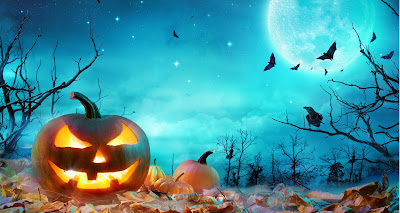Nowadays, few pay attention to the cycles of the Moon, especially if they live in a city. But for others, including farmers and scientists, the Moon has always been a subject of wonder, and for good reason. The Moon affects our everyday lives in ways we do not always suspect.
This year, Halloween falls on a full Moon, the Hunters Moon, which is also a blue Moon. It doesn’t mean the Moon will be blue, only that it's the second full Moon this month, a rare occurrence in itself. And according to the Farmer’s Almanac, we will next see a spectacular Halloween full Moon in the years 2039, 2058, 2077 and 2096. Mark your calendars.
The first full Moon of October was the Harvest Moon on October 1st, the perfect time for a Harvest Festival. In the old days, for many centuries, and still in traditional farms following the Farmer’s Almanac, the Moon dictates the time of planting and Harvest. Using the natural cycles of dormancy, regeneration, blooming, ripening, etc. to their advantage.
For many animals, particularly birds, the phases of the Moon are essential to navigate during migrations. Other species will time their reproduction to coincide with the lunar cycles. The corals time their spawning between October and December, right after a full Moon. The visual effect of this coordinated lunar timing is so dramatic that it can be seen from space. In Africa, Dung beetles navigate at night by the light of the Moon in a perfect straight line to their burrow.
The Moon also regulates the ocean tides and influences women’s reproductive cycles. Women are more fecund (assuming a natural cycle) during the full Moon, and both men and women experience increased libido, which leads to fertility. Ancient Pagan festivals celebrated this fact during the full Moon.
If you take the time, you’ll notice that important movable events (like some religious holidays) are scheduled on or as close to the full Moon as possible, when people have more energy. It’s not a coincidence. It’s also true of certain conventions and conferences who want to attract more people, and these auspicious dates are often booked far in advance.
My mother, who was a hairdresser, told me always to cut my hair a few days after the full Moon, because hair grows faster when the Moon is full, and if you wait, your haircut will look fresh longer. To this day, I still respect that rule.
The Moon affects our circadian cycles as well. During the full Moon, people complain of not sleeping well and experience Increased energy. This wide-awake state is also responsible for full Moon madness in emergency rooms, and increased number of births in maternity wards – Even the babies want to come out and play. Ask any emergency doctor, maternity nurse, police officer, or EMT, and they will confirm this fact.
So, this year, we are expecting an energy-filled Halloween night. As for the repercussions in our backyards, coyotes will howl, dogs will bark, and cats will roam longer than any other night. If you plan to take part in the fun, be safe and enjoy.
But if you are looking forward to a good read with a cup of cocoa by the fire, here are a few suggestions:
 |
| Find it HERE |
WHITE TIGER
Chronicles of Kassouk
by Vijaya Schartz
Sci-fi romance
$1.49 in kindle now HERE
On the frozen plains of Kassouk, where a few aliens rule a medieval Human world, Tora, Human warrior trained by tigers, seeks her father’s murderer. But what she finds at the point of her sword confuses her. How dare Dragomir, the handsome Mutant, question her bloodline and her loyalties? And could a new enemy control the savage hordes of the fringe?
Dragomir offers to help, but Humans and Mutants are forbidden to fraternize under penalty of death... Should Tora trust her mind, her instincts, or her heart?
In the vortex of war, treason and intrigue, among blizzards, avalanches and ambushes, Tora sets out to solve the mystery of her father’s death. When she unveils the secret of her birth, she realizes Dragomir is the key, and together, they must save their planet from the invaders and fulfill their destiny... if they can survive dire persecutions from those they mean to protect.
"...an exceptional tale that belongs in a place of honor on keeper shelves everywhere." Coffee Time Romance - 5-cups
"...this is one futuristic that you do not want to miss!" Fallen Angels Reviews - 5 angels - Recommended Read
"...kept me enthralled from the first page...a thrilling science fiction romance" Paranormal Romance Reviews
"I'm adding this to my 'keeper' shelf and on the 'to be re-read' list." The Road to Romance
Vijaya Schartz, author
Strong Heroines, Brave Heroes, cats

















































